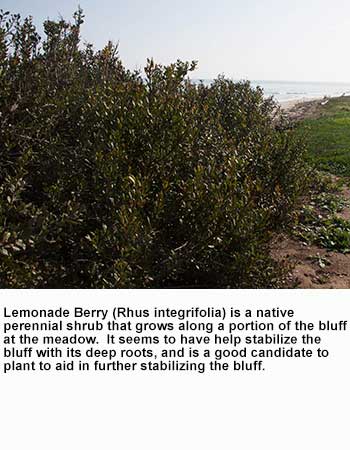What is Growing at the Meadow Now?
As of this writing (winter 2016/17) there are at least 21 weeds that are not native to California are growing at the meadow compared to three that are native. These plants originated mostly in the Mediterranean region of Europe but a few also introduced from South Africa and New Zealand. Although these plants can look attractive during the rainy season, most of them quickly die in the dry months.
Unfortunately, Shalawa (Hammond's Meadow) is dominated by non-native by introduced plants that are outcompeting the few native plants that are present, including Datura wrightii. The project is designed to lessen the non-native plants and to bring back the natives that grow naturally along the coast. These plants provide higher quality habitat for native animals, and by removing the weeds, we will give the native plants a fighting chance to survive and not be pushed out by the introduced plants.
To follow is a partial list of the non-native plants present at Shalawa, and we provide photos of a few of the most common of them followed by photos of the few native plants that still grow at the meadow. Keep in mind, this is only a partial list of the non-native plants.
Common Non-Native Plants:
A Complete List of Non-Native Plants Growing at the Meadow
| Anagallis avensis | Scarlet Pimpernel |
| Avena fatua | Wild Oats |
| Brassica nigra | Black Mustard |
| Bromus diandrus | Ripgutgrass |
| Carduus pycnocephalus | Italian Thistle |
| Carpobrotus edulis | Freeway Iceplant |
| Chenopodium murale | Nettle-leaved Goosefoot |
| Delairea odorata | Cape Ivy |
| Ehrharta erecta | Vel Grass |
| Euphorbia peplus | Petty Spurge |
| Malva parviflora | Cheeseweed |
| Malva pseudolavatera | Cretan Mallow |
| Marrubium vulgare | Horehound |
| Myoporum laetum | Myoporum |
| Oxalis pes-caprae | Sourgrass, Bermuda Buttercup |
| Pennisetum clandestinum | Kikuyu Grass |
| Ricinis communis | Castor Bean |
| Salsola australis | Russian Thistle |
| Sisymbrium orientale | Sisymbrium |
| Solanum douglasii | Douglas’ Nightshade |
| Sonchus oleraceus | Common Sowthistle |



